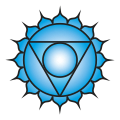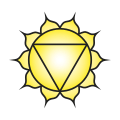Chakra
A chakra is an energy center in the human body as taught in Indian yoga and some related cultures. Chakras are also believed in by some New Age adherents. Chakra means ‘Aneel or wheel' in Sanskrit.
According to people who believe in their existence, a chakra is an area in the body connected with life energy. They say that there are seven chakras in the body - each is an interface for the flow of life energy. They say that a chakra vitalizes a physical body and is associated with interactions of a physical or mental nature. They also say that current science is not able to detect or measure chakras.[1]
Definitions
Although there are various interpretations as to what exactly a chakra is, the following features are common in all systems:
- They form part of a subtle energy body, along with the energy channels, or nadis, and the subtle winds, or pranas.
- They are located along a central nadi, Sushumna, which runs either alongside or inside the spine.
- Two other nadis, Ida and Pingala, also run through the chakras, and alongside Sushumna. They occasionally cross Sushumna at the location of the chakras.
- They possess a number of 'petals' or 'spokes'. In some traditions, such as the Tibetan, these spokes branch off into the thousands of nadis that run throughout the human body.
- They are generally associated with a mantra seed-syllable, and often with a variety of colours and deities.
Types of Chakras
The seven main chakras are described as being present in an ascending column from the base of the spine to the head. The chakras are usually connected with a certain color. Each chakra is also connected with some part of consciousness.
The following seven primary chakras are commonly described:
- Muladhara (Sanskrit: मूलाधार, Mūlādhāra, Thai: มูลาธาระ) Base or Root Chakra (ovaries/prostate)
- Swadhisthana (Sanskrit: स्वाधिष्ठान, Svādhiṣṭhāna, Thai: สฺวาธิษฺฐานะ) Sacral Chakra (last bone in spinal cord, the coccyx)
- Manipura (Sanskrit: मणिपूर, Maṇipūra, Thai: มณีปูระ) Solar Plexus Chakra (navel area)
- Anahata (Sanskrit: अनाहत, Anāhata, Thai: อนาหะตะ) Heart Chakra (heart area)
- Vishuddha (Sanskrit: विशुद्ध, Viśuddha, Thai: วิศุทฺธะ) Throat Chakra (throat and neck area)
- Ajna (Sanskrit: आज्ञा, Ājñā, Thai: อาชฺญา) Brow or Third Eye Chakra (pineal gland or third eye)
- Sahasrara (Sanskrit: सहस्रार, Sahasrāra, Thai: สหัสฺราระ) Crown Chakra (top of the head; 'soft spot' of a newborn)
- Chakras
- Root chakra (Muladhara)
- Navel chakra (Swadhisthana)
- Solar plexus chakra (Manipura)
- Heart chakra (Anahata)
- Throat chakra (Vishuddha)
- Third eye chakra (Ajna)
- Crown chakra (Sahasrara)
Chakra Media
Chakra iconography may derive from the five symbols of yajna, the Vedic fire altar.
Related pages
References
- ↑ "Purification and disclosure of human chakras". Archived from the original on 2021-12-04.
- Introduction to Chakras from Kheper.net
- BelindaGrace (2007). You are Clairvoyant - Developing the secret skill we all have. Rockpool Publishing. Archived from the original on 2013-08-14. Retrieved 2011-04-10.
- Woodroffe, John (1919). The Serpent Power. Madras, India: Ganesh & Co. ISBN 0-486-23058-9.















